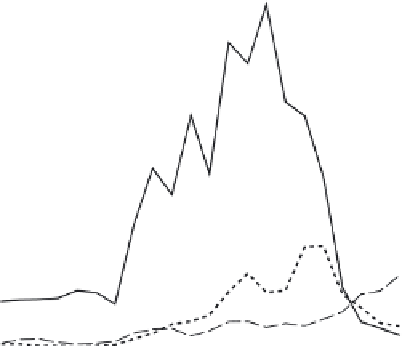Geography Reference
In-Depth Information
50,000
Hong Kong
Taiwan
Republic
of Korea
40,000
30,000
20,000
10,000
0
1980
1985
1990
1995
2000
Figure 3.1
Hong Kong, Taiwanese and South Korean landings in Canada, 1980-2001 (
Source
: LIDS
data base)
for the next decade Hong Kong was the leading source of immigrants. But
1989 was a decisive year with the terror of Tiananmen Square being a major
source of de-stabilisation amongst Hong Kong's middle class (Figure 3.2);
applications to Canada reached a pinnacle of over 50,000, a level that was
almost sustained for the next two years, before falling substantially. The
peak of applications was delayed for three years before showing up in
Canadian landings that reached their own maximum between 1992 and
1994. It is clear that most of the middle class who had wanted to leave had
already done so by the mid 1990s and numbers fell off dramatically after
1997. The disclosure of foreign assets that became a controversial part of
Canadian income tax law discouraged new migrants and sent others home,
while the devastating Asian financial crisis that began in late 1997 severely
depreciated liquid assets for a decade. In the 1980s and the first half of the
1990s many middle class families leaving Hong Kong had bankrolled their
move by property sales, benefiting from the huge real estate inflation of the
1980s. But land values tumbled at the end of the decade, and late in 2006
apartment prices in Hong Kong, while recovering from the SARS-induced
trough in 2003, still remained almost 50 percent below the mid-1997 peak,
leaving many middle class owners mired in negative equity and in no posi-
tion to emigrate (Government of Hong Kong 2007).
14
In contrast to Hong Kong flows, Taiwanese migration picked up later and
declined more gradually, so that by the turn of the millennium Taiwanese















































































